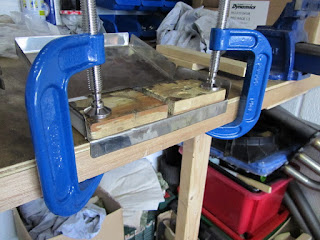A little change from the wiring, but also in the vein of creating fixed end points for things; I started to think about the firewall, and with it the the pedal box.
Firewall
The firewall sits flush with the chassis tube on the rear edge (I think - by deduction - unable to find other references), i.e. other side of this picture - I've marked out the drill points on the masking tape; but its waiting for M6 cap head bolts before I go further:
Next up was fitting the pedal box, as it stands all the folds on the box are somewhat open/large radius and it doesn't really line up. The accelerator pivot goes through one side so this - with the position of the firewall provides a datum for mounting.
Pedal Box Cover
The pedal box cover needs bending in the middle. I don't have a metal bender so setup some scraps of wood, fixed everything in place with clamps & gradually pushed it into place by hand:
Next the top edge isn't bent at all; this needs a 90 degree bend which is achieved using some scraps of timber to hold it in place and more timber as a 'soft' lever to push it over followed by some light hammering to tighten the bend:
Pedal Box
The box itself sat to high as it was and would not let the accelerator pivot bolt slide into place. Taking care to line everything up & take account of the panels it will sit on, i.e. the box sits against the firewall & partly on the scuttle tray, I tightened up some of the bends. I used the fixed 'true' corner on my bench, clamped in place with scraps of wood then hammered over the bend with a claw hammer. I went along both edges to make sure the resulting corner (bottom to back edges) was still square:
This is the result, pedal box sitting in place with the accelerator bolt now able to sit squarely through the side hole into the chassis hole. I also cut out a recess bottom right so the box sits square around the clutch cable support:
Final check was to install the brake reservoir (a little brake fluid on the rubber grommets required to allow it to push fit into the master cylinder). The pedal box cover currently sits on the reservoir; when I drill the cover fixing bolts I'll make sure to give it a little clearance:
I also went around all the exposed edges with a small grind stone on the Dremel to remove the worst of the laser cut sharp edges.
I need to think through which parts of the scuttle & battery tray will be removable - it would be good to leave access to under the tray without leaving obvious long joints which will allow water/weather to get in.
Issues
1. I need some M6 x 20mm cap head bolts for the cover & firewall mounting; waiting on Screwfix until Tuesday (picked up 20th Sept)...
2. The accelerator pedal is far too wide to fit in the pedal box, its pivot tube is long by a 10mm at least, need to double check before cutting it, but presumably I can just cut it down to fit.
3. All these parts, pedal box, battery tray etc are located according to the notches in the side panels so nothing can be fixed at this point



















































